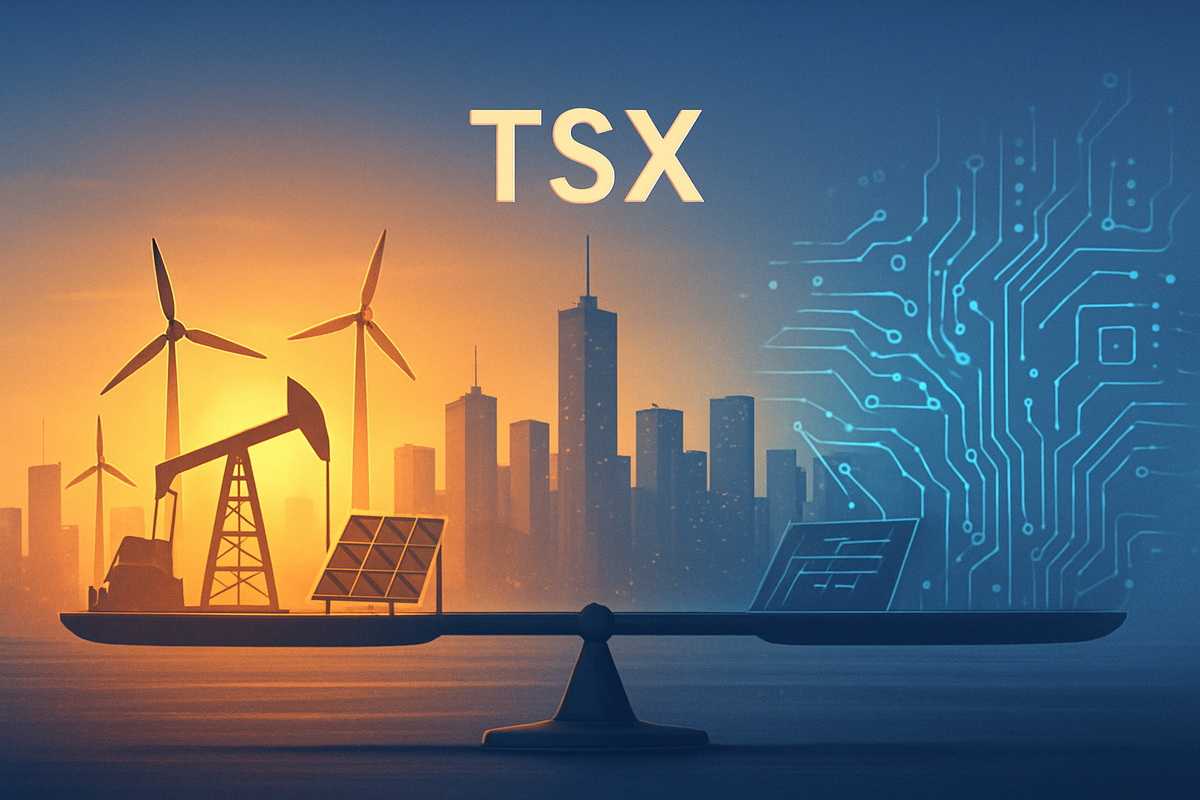
The S&P/TSX Composite Index has recently demonstrated a characteristic of resilience, maintaining a relatively flat trajectory even amidst dynamic sectoral shifts. This equilibrium is largely attributed to the robust performance of Canada's energy sector, which has provided substantial gains, effectively counteracting the headwinds faced by technology shares. This delicate balance highlights a Canadian market heavily influenced by commodity prices, while also grappling with investor caution regarding the tech industry's valuation and broader economic uncertainties.
This intricate dance between surging resource-based stocks and a retreating technology sector has become a defining feature of the TSX's immediate performance. It signals a market in a holding pattern, where the underlying currents of global commodity demand and domestic economic sentiment are pulling in different directions, leaving investors keenly awaiting definitive catalysts to break the stalemate.
Detailed Market Dynamics and Sectoral Tug-of-War
The recent performance of the S&P/TSX Composite Index paints a picture of a market finding stability through contrasting sectoral movements. While the index experienced a strong rally on November 10, advancing 1.4% and settling at 30,317 points, primarily fueled by surging commodity prices and optimism surrounding the resolution of the U.S. government shutdown, it opened relatively flat on November 11. This flatness was a direct consequence of significant gains in energy shares effectively offsetting losses observed within the technology sector, illustrating the index's reliance on its resource-heavy components.
The timeline leading up to this moment reveals a dynamic period for the Canadian market. October marked the sixth consecutive positive monthly return for the TSX Composite, with a 1% gain, demonstrating consistent upward momentum. However, the subsequent "flat" periods indicate a consolidation phase, where the market is absorbing previous gains and reacting to sector-specific news. Key players in this scenario include the major energy producers and explorers listed on the TSX, whose fortunes are closely tied to global oil and gas prices, and prominent technology firms, particularly those with high growth expectations. The initial market reaction has been one of mixed sentiment, with some investors viewing the tech sector's pullback as an opportunity for value investing, while others remain cautious given broader economic growth concerns.
The energy sector's strength has been a primary driver of the TSX's stability. As of November 5, the energy industry recorded a 1.0% increase in the last week and an impressive 13% gain over the past 12 months. This robust performance is largely attributed to higher oil prices, which surged in October following U.S. sanctions on Russian oil companies, and strong global demand prospects. On November 5, the Energy Capped Index notably climbed 2.75%, with several individual energy companies posting significant gains. This underscores the pivotal role of Canada's resource-focused shares in providing a resilient floor for the overall market.
Conversely, the technology sector has faced considerable headwinds. On November 6, the TSX finished lower, largely "weighed down by losses in the technology sector." Influential technology stocks, such as Shopify Inc. (TSX: SHOP), experienced declines, even after reporting strong third-quarter results. This suggests that elevated valuations and high investor expectations might be contributing to profit-taking and a re-evaluation of growth prospects within the sector, aligning with broader technology-driven selloffs observed in U.S. markets. This contrasting performance between energy and technology sectors is the core reason for the TSX's overall flat yet stable movement.
Companies Navigating the Crosscurrents
In this environment, companies within the energy and technology sectors are experiencing vastly different fortunes. Energy producers and service providers are likely to be among the primary beneficiaries. Companies like Canadian Natural Resources (TSX: CNQ), Suncor Energy (TSX: SU), and Cenovus Energy (TSX: CVE), with their significant exposure to oil and gas production, are directly profiting from elevated commodity prices. Increased cash flows from higher prices allow these companies to reduce debt, increase shareholder returns through dividends or buybacks, and potentially fund new projects, bolstering their stock performance and contributing positively to the overall TSX.
On the losing side, several technology companies, particularly those that experienced rapid growth and high valuations in previous periods, are feeling the pressure. Shopify Inc. (TSX: SHOP), a bellwether for Canadian tech, has seen its stock decline despite strong fundamentals, suggesting investor concerns about future growth rates or valuation multiples in a rising interest rate environment. Other high-growth tech firms might also face similar challenges, as investors rotate out of growth stocks into more value-oriented or cyclical sectors like energy, which tend to perform well during periods of inflation or commodity booms.
The ripple effects extend beyond these two sectors. Financial institutions, for instance, are indirectly affected. Banks with significant lending exposure to the energy sector could see improved asset quality and profitability as energy companies thrive. Conversely, a slowdown in the tech sector could impact venture capital funding and tech-focused lending. Industrial companies that supply to the energy sector could also see increased demand for their products and services, while those reliant on tech sector growth might face reduced orders.
This sectoral divergence also highlights the investment thesis for different types of funds. Value and income-oriented funds with a heavier allocation to energy and materials are likely outperforming growth funds focused on technology. This dynamic encourages a re-evaluation of portfolio allocations as investors seek to capitalize on the strengths of the commodity cycle while navigating the volatility of the tech space.
Wider Significance and Broader Market Implications
The current flat performance of the TSX, characterized by energy gains offsetting tech losses, fits into a broader global trend where commodity-linked economies are demonstrating resilience amidst fluctuating investor sentiment. This event underscores Canada's inherent strength as a major resource producer, particularly in an environment of sustained high commodity prices. The robust performance of the energy and materials sectors acts as a significant hedge against potential downturns in other, more growth-sensitive sectors, providing a foundational stability for the Canadian economy.
This dynamic has several ripple effects. Competitors in the global energy market, particularly those in the U.S. and other major oil-producing nations, will also benefit from high prices, but the Canadian market's specific composition makes it uniquely positioned. Domestically, companies that provide services or infrastructure to the energy sector, such as engineering firms or transportation companies, are likely to see increased business. Conversely, partners and suppliers to the tech sector might experience a slowdown in demand. Regulatory implications could arise if sustained high energy prices lead to increased focus on carbon emissions or calls for windfall taxes, though current policy seems to favor supporting the sector, as indicated by Canada's ambition to become a "clean energy superpower."
Historically, the TSX has often been described as a "resource-heavy" index, and its performance has frequently mirrored the cycles of global commodity prices. This current situation is reminiscent of past periods where strong commodity markets bolstered the Canadian economy, even when other sectors faced challenges. For instance, during the commodity supercycle of the early 2000s, Canadian resource companies thrived, contributing significantly to the TSX's overall growth. The current environment, driven by geopolitical factors and supply constraints, echoes these historical precedents, reaffirming the enduring influence of natural resources on Canada's financial landscape.
The recent federal budget, with its focus on increased defense spending and the ambition to become a "clean energy superpower," further solidifies the government's commitment to strategic sectors, including energy. This policy direction could provide additional tailwinds for the energy sector, even as global efforts towards decarbonization continue. The interplay between traditional energy strength and emerging clean energy initiatives will be a critical trend to watch, potentially shaping the long-term trajectory of the Canadian market.
What Comes Next: Navigating Future Market Landscapes
Looking ahead, the short-term outlook for the TSX suggests a continuation of the current sectoral tug-of-war. Energy prices will remain a critical determinant, with geopolitical developments and global demand influencing their trajectory. Any sustained increase in oil prices could provide further impetus for the energy sector, potentially pushing the TSX higher. Conversely, a significant correction in oil prices could expose the market to greater downside risk, especially if the technology sector continues to struggle with valuation concerns.
In the long term, the Canadian market may see strategic pivots as companies and investors adapt to these evolving conditions. Energy companies might continue to invest in efficiency improvements, explore new extraction technologies, and gradually transition towards cleaner energy sources to align with broader environmental goals while still capitalizing on current demand. Technology companies, on the other hand, may need to focus more on profitability and sustainable growth models rather than purely top-line expansion to regain investor confidence. This could involve consolidation, strategic partnerships, or a renewed emphasis on innovation that delivers clear, tangible value.
Market opportunities could emerge for investors willing to look beyond the immediate headlines. High-quality technology stocks that have been unfairly penalized during the sector-wide correction might present attractive entry points. Similarly, companies within the renewable energy space, which align with Canada's "clean energy superpower" ambition, could see increased investment and growth. Challenges include navigating potential economic slowdowns, as indicated by the Bank of Canada's dimmed economic growth projections for 2025, and managing the impact of rising trade tensions and weaker consumer spending.
Potential scenarios range from a continued "muddle-through" where the TSX remains range-bound, oscillating between energy-driven gains and tech-driven losses, to a more decisive breakout if a clear catalyst emerges. This catalyst could be a significant shift in global economic growth, a major policy announcement, or a sustained period of either commodity price strength or tech sector recovery. Investors should prepare for continued volatility and focus on diversified portfolios that can withstand sectoral shifts.
Comprehensive Wrap-Up and Investor Outlook
In summary, the TSX's recent flat performance is a testament to the powerful offsetting forces at play within the Canadian market. The robust gains from the energy sector, propelled by strong commodity prices and geopolitical factors, have effectively cushioned the impact of losses experienced by technology shares, which are contending with valuation concerns and a shift in investor sentiment. This dynamic underscores the enduring significance of Canada's resource wealth in providing market stability, even as other sectors navigate their own challenges.
Moving forward, the market is likely to remain highly sensitive to global commodity trends, particularly oil prices, and the evolving narrative around technology valuations. The interplay between these sectors will continue to dictate the overall direction of the TSX. While the Canadian economy shows resilience, underlying concerns about future growth and potential recessionary pressures, as highlighted by the Bank of Canada's surveys, warrant close monitoring.
For investors, the coming months will require a discerning eye. Watching for sustained trends in commodity prices, shifts in monetary policy from the Bank of Canada, and the earnings reports of key companies in both the energy and technology sectors will be crucial. The ability of technology companies to demonstrate sustainable profitability and for energy companies to continue generating strong cash flows will be key indicators of future market direction. Ultimately, the TSX's path will be shaped by how these powerful sectoral forces resolve their current stalemate, offering both opportunities and challenges for the astute investor.
This content is intended for informational purposes only and is not financial advice







